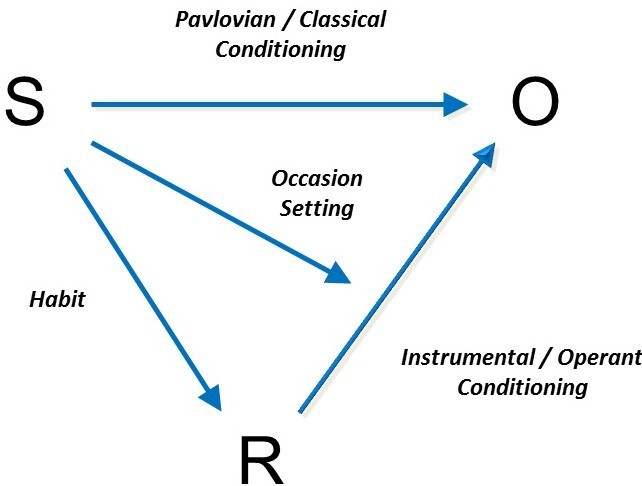Putting Classical and Instrumental Conditioning Together
Classical and operant conditioning are usually studied separately. But outside of the laboratory they almost always occur at the same time. For example, a person who is reinforced for drinking alcohol or eating excessively learns these behaviors in the presence of certain stimuli —a pub, a set of friends, a restaurant, or possibly the couch in front of the TV. These stimuli are also available for association with the reinforcer. In this way, classical and operant conditioning are always intertwined.
The figure below summarizes this idea, and helps review what we have discussed in this module. Generally speaking, any reinforced or punished operant response (R) is paired with an outcome (O) in the presence of some stimulus or set of stimuli (S).
The figure illustrates the types of associations that can be learned in this very general scenario.
For one thing, the organism will learn to associate the response and the outcome (R – O). This is instrumental conditioning. The learning process here is probably similar to classical conditioning, with all its emphasis on surprise and prediction error. And, as we discussed while considering the reinforcer devaluation effect, once R – O is learned, the organism will be ready to perform the response if the outcome is desired or valued. The value of the reinforcer can also be influenced by other reinforcers earned for other behaviors in the situation. These factors are at the heart of instrumental learning.
Second, the organism can also learn to associate the stimulus with the reinforcing outcome (S – O). This is the classical conditioning component, and as we have seen, it can have many consequences on behavior. For one thing, the stimulus will come to evoke a system of responses that help the organism prepare for the reinforcer (not shown in the figure): The drinker may undergo changes in body temperature; the eater may salivate and have an increase in insulin secretion. In addition, the stimulus will evoke approach (if the outcome is positive) or retreat (if the outcome is negative). Presenting the stimulus will also prompt the instrumental response.

The third association in the diagram is the one between the stimulus and the response (S – R). As discussed earlier, after a lot of practice, the stimulus may begin to elicit the response directly. This is habit learning, whereby the response occurs relatively automatically, without much mental processing of the relation between the action and the outcome and the outcome’s current value.
The final link in the figure is between the stimulus and the response-outcome association [S – (R – O)]. More than just entering into a simple association with the R or the O, the stimulus can signal that the R – O relationship is now in effect. This is what we mean when we say that the stimulus can “set the occasion” for the operant response: It sets the occasion for the response-reinforcer relationship. Through this mechanism, the painter might begin to paint when given the right tools and the opportunity enabled by the canvas. The canvas theoretically signals that the behavior of painting will now be reinforced by positive consequences.
The figure provides a framework that you can use to understand almost any learned behavior you observe in yourself, your family, or your friends. If you would like to understand it more deeply, consider taking a course on learning in the future, which will give you a fuller appreciation of how classical learning, instrumental learning, habit learning, and occasion setting actually work and interact.

